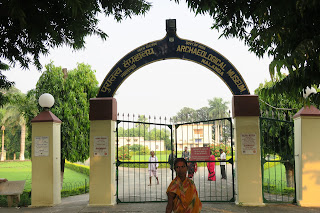Nalanda Museum established in the year 1917 is one of the most prestigious
site-museums of Archaeological Survey of India.
It houses antiquities found from the excavated site of Nalanda Mahavihara
supposedly the earliest university cum monastery complex which flourished
during 5th – 12th centuries of Christian era under the patronage of Gupta,
Maukhari and Pala rulers. Later on few object collected from the neighbouring
villages of Nalanda and few from Rajgir too were added to the treasures of
this museum. There about 350 artifacts at display whereas more than thirteen
thousand are kept in the reserve collection. Display includes stone images and
sculptures, bronzes, stuccos, terracottas, inscription, iron objects, ivory
& bone objects and potteries etc. arranged in four galleries and the main
hall.
The main hall exhibits master pieces of stone and two huge earthen storage
jars. Twelve handed Bodhisattva Avalokitesvara, about two meters high image of
Samantabhadra, Nagaraj with seven serpent hood canopy, a colossal image of
Buddha seated in dharmachakra mudra, a tantric deity Trailokyavijya trampling
Shiva-Gauri, and Buddha seated in bhumisparsa mudra are worth mentioning
specimens in this hall. The central space of the hall has been occupied by a
scale model of the excavated site in a table showcase.
|
Entering Nalanda Archaeological Museum.
The museum established in 1917 houses the antiquities mainly those
excavated from Nalanda, the earliest university cum monastery complex
and from Rajgir.
|
|
Nagas worshipping Shiva lingam.
Height: 14.6 cm (5 ¾ in), width: 6.9 cm (2 ¾ in). Archæological Survey
of India, accession number 10663.
-
The Nagas are a divine, or semi-divine, race of half-human,
half-serpent beings that reside in the netherworld (Patala), and can
occasionally take human or part-human form, or are so depicted in art.
-
Rituals devoted to these supernatural beings have been taking place
throughout South Asia for at least 2,000 years.
-
They are principally depicted in three forms: as entirely human with
snakes on the heads and necks, as common serpents, or as half-human,
half-snake beings in Hinduism, Buddhism, and Jainism.
- Shiva is often shown garlanded with a snake.
-
See more at
Nāga - Wikipedia.
|
|
Heruka, 9th-10th century sculpture.
Heruka is the name of a category of wrathful deities, enlightened beings
in Vajrayana Buddhism that adopt a fierce countenance to benefit
sentient beings. In East Asia, these are called Wisdom Kings.
-
Herukas represent the embodiment of indivisible bliss and emptiness.
They appear as Istha-devata (Tibetan: yi dam) or meditational
deities for tantric sadhana, usually placed in a mandala and
often appearing in Yab-Yum.
-
Heruka represents wrathful imagery with indivisible emptiness
(sunyata), bliss, peace, wisdom, compassion
(bodhicitta), and love.
-
Herukas represent unified consciousness, with emptiness being a
reflection of "non-phenomena" or emptiness which is "all love," or
removal of imagery to reach universal love, mercy, and
compassion-mind.
-
See more at
Heruka - Wikipedia.
|
|
Shiva-Parvati, 12th century sculpture.
Shiva Parvati is the dual representation of the Hindu deities Shiva, and
his consort, Parvati, traditionally featured in their abode, Kailash.
-
Shiva and Parvati are the most supreme deities in Shaivism and are
worshiped by millions of Hindus across the globe.
-
See more at
Shiva Parvati - Wikipedia.
|
|
Vishnu, 9th-10th century sculpture.
Vishnu (lit. 'The Pervader'), also known as Narayana and Hari, is one of
the principal deities of Hinduism. He is the supreme being within
Vaishnavism.
-
Vishnu iconography shows him with dark blue, blue-gray or black
coloured skin, and as a well-dressed jewelled man. He is typically
shown with four arms.
-
See more at
Vishnu - Wikipedia.
|
|
Yamantaka, 8th-12th century sculpture.
A different form of Krishna Yamari, with six heads, six arms, and, in
theory, six legs, standing on a buffalo, wearing a tiger skin loin cloth
and a garland of severed heads. He wields a sword and a lasso in his top
hands, the remaining attributes normally are a vajra sceptre and vajra
bell (normally in his main hands crossed over his heart), a staff and a
skull cup.
-
Yamantaka or Vajrabhairava is the "destroyer of death" deity of
Vajrayana Buddhism.
-
Within Buddhism, "terminating death" is a quality of all buddhas as
they have stopped the cycle of rebirth, samsara. So Yamantaka
represents the goal of the Mahayana practitioner's journey to
enlightenment, or the journey itself: On final awakening, one
manifests Yamantaka – the ending of death.
-
See more at
Yamantaka - Wikipedia.
|
See also
Source
Location








